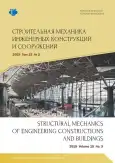Determination of destructive forces in a rod-cable arch
- Авторлар: Dmitriev I.K.1
-
Мекемелер:
- Moscow State University of Civil Engineering (National Research University)
- Шығарылым: Том 15, № 3 (2019)
- Беттер: 243-248
- Бөлім: Experimental researches
- URL: https://journal-vniispk.ru/1815-5235/article/view/346276
- DOI: https://doi.org/10.22363/1815-5235-2019-15-3-243-248
- ID: 346276
Дәйексөз келтіру
Толық мәтін
Аннотация
The aim of research - comparison the results of the experimental data with the computer modeling the work of the strengthened brick-cable arch. Methods. Experimental and theoretical methods of research. Results. Firstly, the tests on a small desktop models were performed, for the determination the nature of destruction of the construction. During them, it was discovered, that the arch crash is taking place because of the splitting the small size timber bricks, or as the result of the breaking its steel strengthening elements. Further, the computer model of the construction was created with the help of physically and geometrically nonlinear finite elements at LIRA-SAPR PC. The generated model was load by a concentrated force at its top zone, the same one, as it had been during the experiments before. On the results of the calculation, the maximum deformation was received, which are different from the experimental one on a value less then 10%, what suggests the nearness the computer model to the real construction. The highest compressive strengths of the arch and the largest stretching forces of its steel bands were determined during the further analysis of the model. Maximum splitting and stretching forces also were calculated theoretically, according to the formulas of SP 64.13330.2017 and SP 20.13330.2016. It was determined that the timber bricks have more than 7 times reserve of strength, and the steel bands over them - only times, and during the growth of external force, the arch will crash because of its steel sprengel bands breakage. By the results of the research, the calculation algorithm of such kind constructions was generated, at the base of LIRA-SAPR PC. It was recommended first, to determine deformation of the strengthened brick-cable arch, with further checking the timber elements for splitting and steel sprengel elements for maximum permissible stretching. The problem of stability the flat form of deformation for the brickcable arch are the same as for the glued one, because of the tight connection the timber bricks, with elimination their exit from the frontal plane.
Авторлар туралы
Igor Dmitriev
Moscow State University of Civil Engineering (National Research University)
Хат алмасуға жауапты Автор.
Email: igkd@yandex.ru
SPIN-код: 6639-7600
Cand. Sci.(Eng), Associate Professor, Metall and Timber Department
26 Yaroslavskoye shosse, Moscow, 129337, Russian FederationӘдебиет тізімі
- Dmitriev I.K. (2015). Research the deformation of the brick-cable arch. Stroitelnaya mekhanika injenernyh konstrukciy i soorujeniy [Structural Mechanics of Engineering Constructions and Buildings], (5), 72-77. (In Russ.)
- Dmitriev I.K. (2010). Issledovanie raboty sterzhnevantovoi girlyandy [Research work rod-cable-stayed garlands]. Promyshlennoe i grazhdanskoe stroitelstvo [Industrial and Civil Construction], (11), 68-70. (In Russ.)
- Dmitriev I.K., Petuhova K.G. (2012). K voprosu vozvedeniya eksperimental'nogo bol'sheproletnogo sterzhnevantovogo kupola [To the question of the construction of an experimental long-span cable-stayed dome]. Promyshlennoe i grazhdanskoe stroitelstvo [Industrial and Civil Construction], (12), 18-19. (In Russ.)
- Dmitriev I.K. (2013). Rezul'taty issledovaniya nesushchei sposobnosti sterzhne-vantovoi girlyandy i formy obolochek na ee osnove [The results of the study of the bearing capacity of the rod-cable garland and the shape of the shells on its basis]. Promyshlennoe i grazhdanskoe stroitelstvo [Industrial and Civil Construction], (9), 4-6. (In Russ.)
- Dmitriev I.K. (2014). Eksperimental'noe issledovanie arochnoi girlyandy [Experimental study of the arch garland]. Promyshlennoe i grazhdanskoe stroitelstvo [Industrial and Civil Construction], (10), 58-61. (In Russ.)
- Lebedev J.S., Temnov V.G. (1980). Prostranstvennye konstruktivnye sistemy bionicheskogo tipa: opyt primeneniya v stroitel'stve [Spatial design systems bionic type: experience in construction]. Leningrad: LDNTP Publ. (In Russ.)
- Temnov V.G. (1987). Konstruktivnye sistemy v prirode i stroitel'noj tekhnike [Structural systems in nature and construction machinery]. Leningrad: Stroyizdat Publ. (In Russ.)
- Lebedev J.S. et al. (1990). Arhitekturnaya bionika [Architectural bionics]. Moscow: Stroyizdat Publ. (In Russ.)
- Schmidt A.B., Dmitriev P.A. (2002). Atlas stroitel'nyh konstrukcij iz kleenoj drevesiny i vlagostojkoj fanery [Atlas of building structures made of laminated wood and moisture-resistant plywood]. Moscow: The Association of the Civil Engineering High Schools Publ. (In Russ.)
- Boytemirov F.A. (2013). Konstrukcii iz dereva i plastmass [Wood and plastic structures]. Moscow: Academy Publishing Centre. (In Russ.)
- Voznesencki S., Hanyhov H. (1970). Obolochki novogo tipa. Arhitekturnaya kompoziciya. Sovremennye problemy [New type shells. Architectural composition. Modern problems], 147-149. (In Russ.)
- Kozlov D.J. (1989). Regulyarnye uzly i zacepleniya - strukturnyj princip kinematicheskih arhitekturnyh konstrukcij. Arhitekturnayabionika [Regular knots and links - a structural principle of kinematic architectural structures. Architectural bionics], 72-82. (In Russ.)
- Kozlov D.J. (1991). Dome structures for flexible material. Roofs. Part 1. Human settlements and sociocultural environment, 27-131.
- Bocco A., Valcárcel E.C.M., Trovato L. (2015). Yona Friedman’s Roofs: manuals for simple, low-cost building. NOCMAT-2015 Proceedings.
- Nerdinger W. (2005). Frei Otto. Complete works. Lightweight сonstruction. Natural design. Birkhauser, Architekturmuseum, TU Munchen.
- SP 20.13330.2016. Loads and impacts. Updated version of SNiP 2.01.07-85*.
- SP 64.13330.2017. Wooden structure. Updated version of SNiP II-25-80.
Қосымша файлдар









